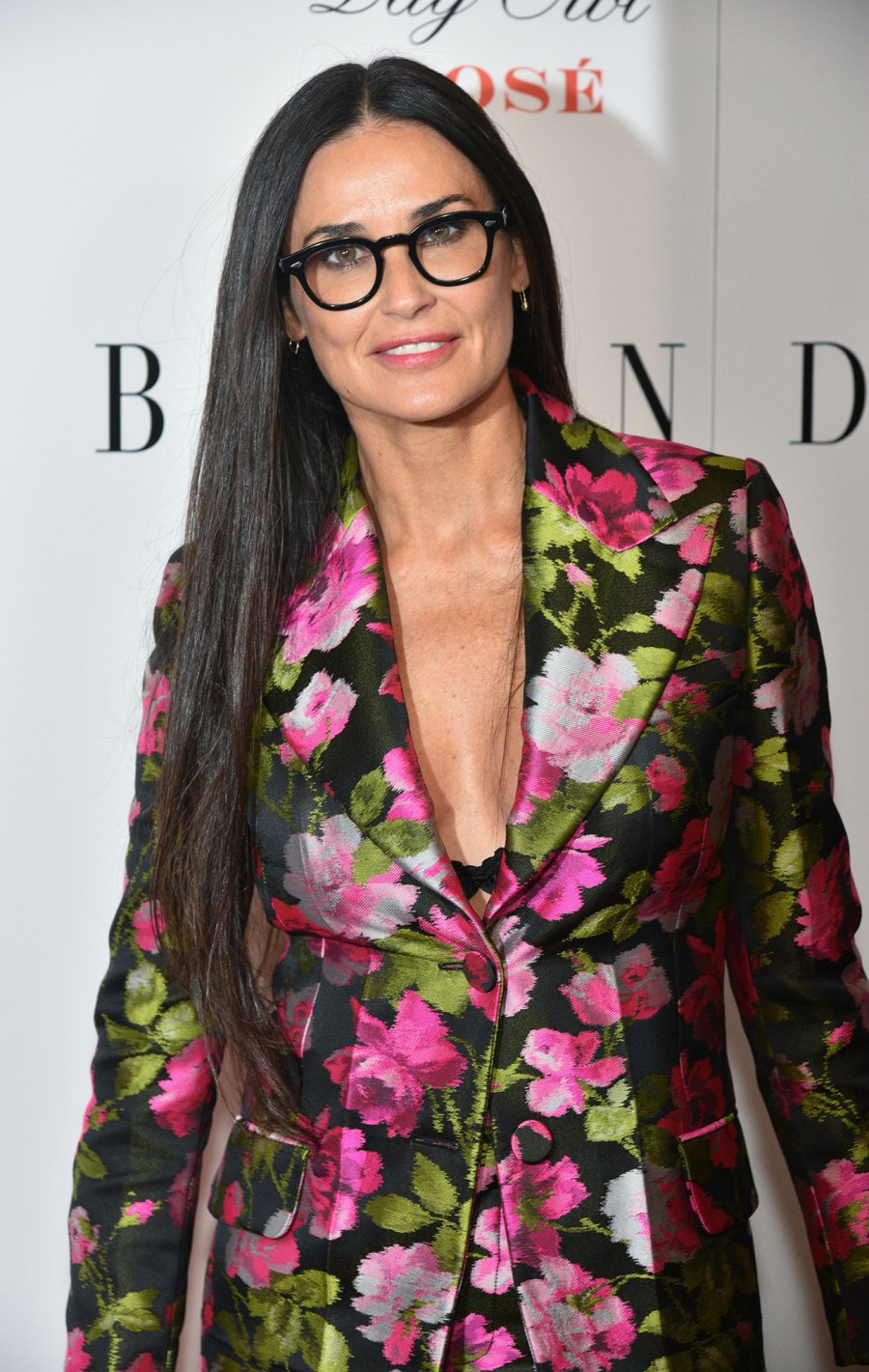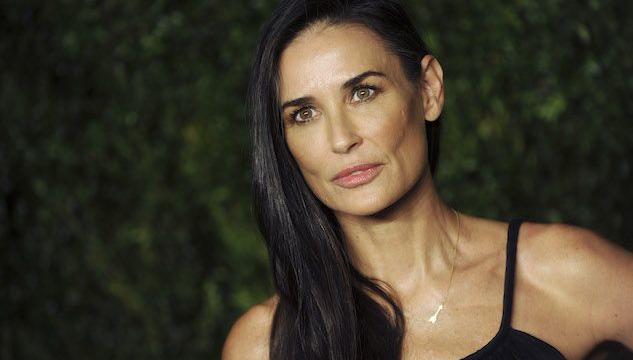
Published at the end of 2019, “Inside Out” is the enthralling tell-all memoir of Hollywood actress Demi Moore. Spread across three large sections – survival, success, and surrender – its 22 chapters detail her traumatic experiences with family conflict, rape, stardom, addiction, motherhood, and infidelity in a way very few celebrity memoirs do: heartachingly candid. So, get ready to follow Demi Moore on her tumultuous journey of reminiscence, rediscovery, and repair, and prepare to meet a different side of the actress!
Demi Moore is an actress, producer, director and activist. She is known for her roles in St. Elmo’s Fire, About Last Night, Ghost, A Few Good Men, Indecent Proposal, G.I. Jane, Charlie’s Angels: Full Throttle, Margin Call, among many others. Moore is also a co-founder of Thorn, a non-profit that builds technology to defend children from sexual abuse, exploitation, and trafficking. Inside Out (2019) is a memoir by Hollywood actress Demi Moore.Here, she turns inward and reports from memory – from her troubled childhood and her rising fame as a member of the “Brat Pack” in the 1980s, to her marriages to Bruce Willis and Ashton Kutcher.
Demi Moore’s parents
Demi Moore’s parents were a magnetic couple. Her father, Danny Guynes, was “very macho” and looked like a “Latin Tiger Woods.” He had “a mischievous twinkle” in his lazy eye, and was “a charming gambler with a great sense of humor.” He was also a newspaper advertising salesman who frequently changed jobs, so the family moved a lot when Demi was a child. Another reason why they sometimes moved was because that was the way her mother, Virginia “Ginny” King, dealt with her husband’s infidelities: she wanted to get him away from “the problem.” The problem, however, seemed to follow Danny around – because it wasn’t a particular woman, but his riding-the-edge character.
Inside Out Demi Moore Book Review

Not that Ginny was much different. “Strikingly attractive, with bright blue eyes, pale skin, and dark hair,” she easily won Danny’s heart while the two were popular Roswell High students. A little older than her, Danny graduated a year before Ginny, so “when he left to go to college in Pennsylvania, she felt insecure – even more so when she found out he had a female ‘roommate.’ So, she did what she would continue to do throughout their relationship whenever she felt a threat: she started seeing another guy to make him jealous.” This particular guy was Charlie Harmon, a young fireman. Ginny even married him, but she divorced him after just two months, because the romance was a poorly planned attempt to get Danny back from college. It had the desired effect: in February 1963, not long after Ginny divorced Charlie, she married Danny. By that time, Demi was already three months old.
At the age of 13, after comparing her parents’ marriage license and her birth certificate (November 11, 1962), she realized that Danny wasn’t her biological father. “Nobody asked me if I was okay, or if I had questions,” she writes in her memoir. “Neither of my parents seemed to care about what this revelation meant to me. They went into the bedroom and kept fighting, or maybe they started having sex – with them there was always a fine line.”
Her mother’s suicide attempt and being raped as a teenager
It was never going to last – this tumultuous relationship. While Demi was dealing with “normal preteen girl stuff,” her parents were coming undone. One spring night, when she was 11 years old, Demi was woken by “the sound of distressed voices and commotion.” She ran into her parents’ room only to find her mother “thrashing and crying,” and her father struggling to hold her down. “Help me,” her father said, and it wasn’t long before Demi noticed an empty bottle of yellow pills by the side of the bed. “The next thing I remember,” she writes, “is using my fingers, the small fingers of a child, to dig the pills my mother had tried to swallow out of her mouth while my father held it open and told me what to do. Something very deep inside me shifted then, and it never shifted back. My childhood was over.”
Danny and Ginni eventually decided to separate. Demi went on to live with her mother in an apartment in West Hollywood. Even though she was merely 15 years old, Ginny took her daughter wherever she went, late-night bars and all. She couldn’t care less that the two looked like sisters, and that the men she flirted with made moves on Demi as well. In fact, she might have even enjoyed it. “It seemed like she was just using me as bait for these men, and as her designated driver, albeit one without a license,” writes Moore.
One night, a man named Val Dumas came over to their table. A wealthy club owner in his late 40s, he seemed more interested in spending time with Demi than with Ginny. At first, Demi enjoyed the attention – lavish lunches with him at his restaurant, Mirabelle – but then she was overcome by “a vague anxiety that there was something not quite right.” She began making excuses to avoid him, but he wouldn’t have it. One day, when she got home from school, Demi found him inside the apartment, waiting for her. Before she could make out how he had gotten the key, he attacked and raped her. Incredibly, that wasn’t the worst part. A week later, to Demi’s utter dismay, Ginny invited Val to help the two move to La Cienega. In the few seconds that she was left alone with him, Val turned to Demi and said: “How does it feel to be whored by your mother for 500 dollars?”

Escape from home and first marriage
Soon after moving to La Cienega, Demi met a 28-year-old guitar player named Tom Dunston. The day after turning 16, she walked out of her mother’s apartment and moved in with him. She never went back. Tom introduced Demi to the burgeoning 80s Los Angeles music scene. One day, he took her to see a new band called The Kats. She immediately fell in love with their guitar player named Freddy Moore. “He changed my life,” she writes, “or at least my name.”
“Quiet and focused and very disciplined,” Freddy – who was 29 and broke off his marriage to be with her – was a calming influence on Demi. Sometimes, even too calming: when her father committed suicide at 36, the always stoic Freddy could only say to the grieving Moore: “There’s no point in crying; there’s nothing you can do now. It’s not going to change anything.”
Danny killed himself in October 1980, just a month before Demi’s 18th birthday. Three months later, Demi married Freddy. The night before the wedding, she snuck out of her bachelorette party and cheated on him. It wasn’t going to be the only time. The second time it happened was on the set of “Blame It on Rio,” the actress’ big break. The 1984 flick – which also starred Michael Kane and Valerie Harper – was shot in Brazil and opened Moore to plenty of new experiences. One night, she slept with a guy named Peter, a second unit camera operator who was also her roommate in Rio. Her marriage with Freddy ended the same year. Even so, she kept his surname to this day.

Success and everything that comes with it
Inside Out Demi Moore Pdf
Sexual freedom wasn’t the only thing Demi discovered on the shoot of “Blame It on Rio”: her Brazilian friends introduced her to drugs as well. Overwhelmed by ambiguous memories, Moore remembers this time as “an awakening in so many expansive and positive ways, offset, unfortunately, by a lot of cocaine. I nearly burned a hole through my nostrils while I was in Brazil.” Simultaneously, Rio helped her grow into a more mature woman and actress – while setting her on a “gradual downward spiral” of alcohol addiction and substance use.
In 1984, she played a young nightclub singer in the romantic comedy “No Small Affair” and callously took the virginity of her movie partner, Jon Cryer – who had fallen madly in love with her in real life as well. Soon after, Moore was invited to read for the part of Jules in “St. Elmo’s Fire,” Joel Schumacher’s new film with Columbia Pictures. Though deemed only “passable” by critics, the movie was an immense box-office success and made Demi Moore an international celebrity. Because the movie also starred Rob Lowe, Emilio Estevez, Ally Sheedy, Judd Nelson, and Andrew McCarthy, Demi Moore’s name now started to appear in the newspaper listings of the “spoiled, partying, entitled juvenile delinquent” members of the infamous Brat Pack of the 1980s.

Moore hated the term – especially since, during the shooting of “St. Elmo’s Fire,” she stopped partying altogether. After Joel Schumacher noticed Demi’s addiction, he tricked her into visiting an alcohol rehabilitation center. And then he conditioned her presence on the movie set with a preliminary 15-day program of sobriety and a 24/7 counselor for the duration of the filming. Moore writes – “To this day, I see this as some version of divine intervention. […] ‘St. Elmo’s Fire’ will always be the movie that changed my life. If I hadn’t gone to rehab to make that film, I really wonder if I’d still be alive.”
Marriages with Bruce Willis and Ashton Kutcher
During the filming of “St. Elmo’s Fire,” Moore started dating Emilio Estevez. The pair even planned to marry, but just after mailing the invitations, Demi found out that he had been cheating on her. The two broke off the engagement, but remained friends and even went together to the premiere of Estevez’s movie, “Stakeout,” a few months after breaking up. It was there that Moore met Bruce Willis, the man she would spend with the next 13 years of her life. The two had two weddings: a quick ceremony in Vegas on November 21, 1987, and a lavish TriStar-sponsored celebration a month later. They also had three daughters together: Rumer (born nine months after the wedding), Scout (born 1991), and Tallulah (born 1994).
During this time, Moore got addicted to exercising. The obsession began with her training for the 1992 movie “A Few Good Men,” and it went on for the next five years, during which she filmed “Indecent Proposal,” “Striptease,” and “G.I. Jane” – three movies for which she needed to have a nice figure, despite giving birth three times. For “Striptease” (1996), Moore received an unprecedented paycheck of over $12 million – making her the highest-paid actress in Hollywood. The same year, Willis was paid over $20 million for the third movie in the “Die Hard” series. To this very day, points out Moore, “a man is worth almost double what a woman is” in Hollywood. “But instead of people seeing my big payday as a step in the right direction for women or calling me an inspiration,” she remembers, “they came up with something else to call me: Gimme Moore.”
Willis and Moore divorced in 2000. Three years later, she started seeing Ashton Kutcher, 15 years younger. Two years into the marriage, at the age of 42, she got pregnant for the fourth time, but miscarried. “I was decimated,” she writes. “I tried to allow myself to mourn, but it was so confusing. How could I grieve a person who’d never been in the world?” Kutcher wasn’t a faithful husband – nor was mature enough to see her falling off the wagon yet again. He was more interested in bringing a third person into the couple’s bed – to which Moore agreed. That was, however, the beginning of the end of their relationship: citing irreconcilable differences, the couple divorced in 2013.
Inside Out Demi Moore Book Review
Final Notes
“Inside Out” candidly portrays Demi Moore’s descent into the fires of hell. But this feels therapeutic, because a different person rises from the ashes of this autobiography, one capable of owning her mistakes, “a fully formed… woman of wisdom.”
As The Guardian wrote, the book “achieves what every good celebrity memoir should: it makes you look at the subject differently, and Moore emerges as simultaneously more relatable and more remarkable.”
12min Tip
Instead of letting them haunt you, face your traumas. It may be painful – but it will be painful once. Otherwise, it will hurt forever.




